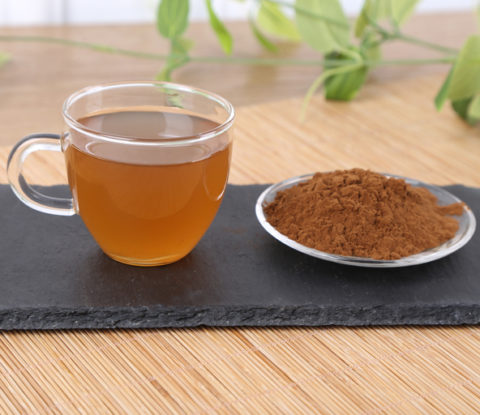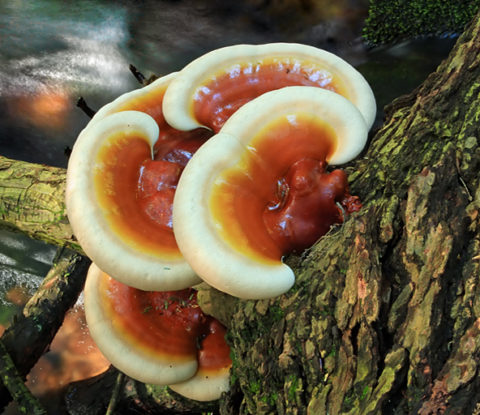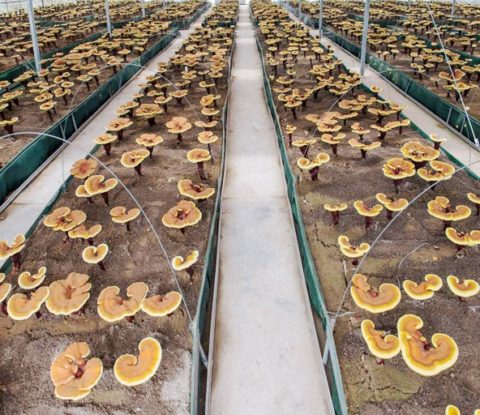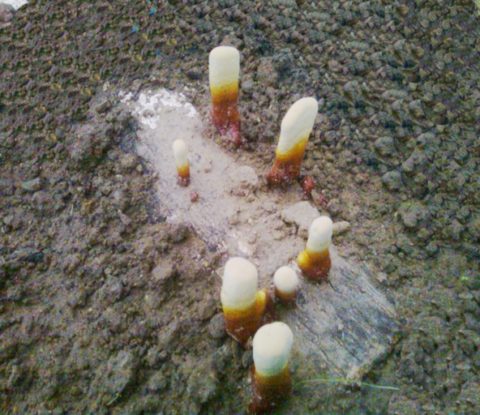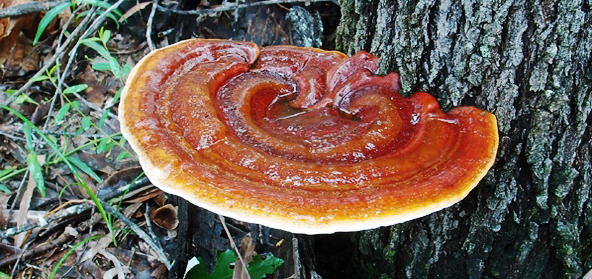
Reishi Mushroom Extract Powder(Ganoderma Lucidum)Polysaccharide>30%UV, Triterpene>2% HPLC
【Latin name】: Ganoderma lucidum (Leysser.Fr)Karst
【Other names】: Red reishi mushroom, Ling zhi
【Plant part used】: mycelium& fruiting body
【Testing methods】: UV&HPLC
【CAS No.】: Polysaccharide, 9012-72-0; Triterpenoid, 81907-62-2.
【Appearance】: Brownish fine powder
【Particle size】: 100% pass 80 mesh
【Main Function】 : Stimulate Immune System
Ganoderma Lucidum(Red Reishi Mushroom) Extract Powder
【Specification】:
Ratio Extract: 10:1, 20:1, 50:1TLC
Standard Aqueous Extract:
Polysaccharide 10%, 20%, 30%, 40%, 50% UV, Triterpenoid 2% HPLC
BETA D Glucan 30-50% UV; Triterpenoid 1-2% HPLC
Standard Aqueous & Ethanol Extract:
Polysaccharide 30%, Triterpenoid 2% HPLC; Polysaccharide 10% UV, Triterpenoid 4%, 6%, 8% HPLC
Shell-broken Ganoderma lucidum (Reishi) spore powder:
polysaccharide>2%, triterpenoid 4%, shell-broken ratio>98%, 300 mesh.
Our reishi mushroom extract adopts Ganoderma Lucidum as the raw material which holds a place in a variety of Asian traditional medicine; it is most well known as Reishi, the name given to the mushroom by practitioners of Japanese medicine. In Traditional Chinese Medicine it is known as Lingzhi, and Korean medicine refers to it as Yeongji; in Taiwan it is sometimes referred to as Ling-Chih. Other complimenting names given to Ganderma Lucidum include The 10,000 year Mushroom, and the Mushroom of Immortality. The praise it receives is in part due to its bioactive effects, but may also be affected by the modes of distribution in the past. According to the year 2000 edition of the State Pharmacopoeia of the People’s Republic ofChina, Ganoderma Lucidum “acts to replenish Qi, ease the mind, and relieve cough and asthma, and it is recommended for dizziness, insomnia, palpitation, and shortness of breath”.
Comparison of (Ganoderma)Reishi Mushroom Types
In the Chinese Pharmacopoeia (v.2000), both Ganoderma Lucidum (Red Lingzhi) and GanodermaSinensis (Purple Lingzhi) are listed as Lingzhi. Despite both being referred to as Lingzhi in Chinese medicine, these two species have some shared and differing properties. The term Ling Zhi can extend to more mushrooms, and ancient Chinese texts (ShenNong Ben Cao Jing and from the Han Dynasty and Ben Cao Gang Mu from the Ming Dynasty, the latter of which is considered the first pharmacopoeia) indicated up to 6 types of Ling Zhi. The possible other Ganoderma mushrooms implicated here are Ganoderma Atrum, Ganoderma Luteum, Ganoderma Tsugae, Ganoderma Tropicum, Ganoderma Tenue, Ganoderma Applantum, Ganoderma Asutrale, and Ganoderma Capense. Ling Zhi was used as medicine. Ganoderma Lucidum is seen as the ‘most medicinal’ Ling Zhi, and is the strain that permeates into Korean and Japanese (Kampo) medicine.
They (in reference to the two main strains, Purple and Red Lingzhi) differ in levels of the bioactive ergosterol and some triterpenoids and the genetic influence of triterpenoids on monocytes (immune cells) shares about 26% similarity between species at best; polysaccharide content does not differ as significantly. Beyond species, different locations that grow Ganoderma Lucidum can markedly differ in quantities of bioactives. At least one study investigating over-thecounter reishi mushroom extract noted that out of 11 randomly selected products, the triterpenoids ranged from indeterminate to 7.8% and polysaccharides from 1.1-5.8%, the differences was attributed to differences in production method (with water soluble extracts possessing less triterpenoids) and growth conditions. One study growin reishi mushroom extract noted somewhat similar levels of triterpenoids overall, but the specific triterpenoids fluctuated wildy between samples
Why Duanwood Ganoderma Lucidum(Red Reishi Mushroom Extract) Gains Highest Potent?


Twenty years ago, Japanese Dr. Yoshi discovered that reishi mushroom extract possessed cancer healing properties. The Japanese government wasted no time in sending him to China in search of the finest, highest quality and most potent reishi mushroom.Through much research and lab tests it was discovered that Duanwood reishi prevailed as meeting the requirements Dr. Yoshi had set. Duanwood reishi specifies that it has been grown on specific types of hardwood indigenous to specific areas of China. It is the fruiting bodies of the red reishi mushroom. Duanwood reishi has the highest concentration of powerful, plant-kingdom medicinal agents, called phytonutrients.
It is also common in the field of medicinal mushrooms to use the immature bodies of the mycelium, which is the stage of the mushroom between the spore and the mature adult body. In most cases, these mushrooms are cultivated in grain slurry, in a box, with a small growing period. It costs considerably less money to produce mycelium, and when you get the final product, it is half minimally potent mushroom and half the grain slurry the mushroom was not able to digest. When dealing with Duanwood reishi mushroom extract, you are ensured the highest quality of mushroom, grown on hardwood in nutrient-rich soil, where the mushroom is able to obtain the essential phytonutrients it needs for its powerful health benefits. The government actually regulates Duanwood reishi, as it is forbidden to use chemicals or pesticides in the growing process, so you can be assured that you are also getting a one hundred percent organic product.
Red Reishi Mushroom/Ganoderma Lucidum Compositions
Mushrooms in general tend to be 90% water or so, which makes a basic mushroom ‘extract’ dehydrated mushroom powder (and thus 1g reishi mushroom extract, if unspecified, may be about as potent as 10g of the mushroom). Beyond that, they tend to be a good source of protein (10-40% of the non-water weight) carbohydrates (3-28%), fiber (3-32%) and then trace Essential Vitamins or Minerals. Ganoderma is on the high end for fiber, low end for carbohydrate, moderate to high end for protein and has a relatively low ash (mineral) content. Beyond the basics, Ganoderma Lucidum possesses unique bioactive molecules including:
•A variety of Bioactive polysaccharides that tend to be the components that interact with the immune system and are subdivided into β-1,3-glucans and polysaccharide peptides like peptidoglycan.
•Water-soluble Polysaccharide Peptides, or carbs with amino acids in the structure. They include GLPS peptide (GLPP), GLPG, GLIS, PGY, and F3
•β-1,3-Glucans (subset of polysaccharides) sometimes called ‘Curdlan’ and some other Glucan molecules
•Over 120 triterpenoid compounds which can be separated into those with a carboxylic side chain (Ganoderma Acids) and those without (Ganoderma alcohols). Some are referred to as lucidenic acids
•Nucleotide bases (thymine, uridine, inosine, guanosine, adenosine) the sum of all ranging from 303-1217mcg/g (in the mushroom cap) and 22-334mcg/g in the stem.
•Some bioactive proteins, such as LZ-8 (Lingzhi-8) and Ganodermin
•A 114kDa hexameric lectin, a glycoprotein with 9.3% sugar
•A reversible and highly specific competitive alpha-glucosidase inhibitor known as SKG-3 with an IC50 value of 4.6mcg/mL
•Ergostane sterols and ergosterol, known as pro-vitamin D2
•C19 fatty acids (nonadecenoic acid and cis-9-nonadecenoic acid)
•Riboflavin
•Vitamin C
•Copper and Zinc
•Selenium at up to 72mcg/g dry weight (best estimate of wet weight is 7.2ug/g) and can biotransform selenium into selenium-containing proteins
•Germanium (the ion, not to be confused with Geranium) at up to 489mcg/g
There is also a large Chitin content in the Ganoderma Lucidum mushroom, which is indigestible (and for the most part, not bioactive) and makes the mushroom tough to chew. The mushroom is hazel/red in color, which is due to the polysaccharide content.
The Actions of Reishi Mushroom Extract Polysaccharides
Reishi is officially listed as a substance for treating cancer by the Japanese government. In comparison to its other properties, Reishi has received the most attention as a source of antitumor activity. This action is due to immunostimulating polysaccharides, particularly those known as Beta-D-Glucans. Dr. Fukumi Morishige, M.D., Dr. Med. Sci., Ph.D., a former heart surgeon and cancer surgeon, did extensive research on the action of Reishi on the immune system. He gave two groups of patients Reishi mushroom extracts. In those patients who had shown high readings of immunoglobulins (IgA, IgG, IgE, IgM), their counts had lowered, while those who previously had low counts now showed the same antibodies in higher counts.
In 1979, researchers in Poland found that an RNA from Reishi disrupts viral diseases by inducing the production of interferon. This RNA was found in the fruit body of Reishi and in higher levels in the mycelium. Reishi mushroom extract polysaccharides increase RNA and DNA in the bone marrow where immune cells such as lymphocytes are made. One of the active polysaccharides is called D6. Researchers in Beijing injected it into mice for a week and then monitored the changes in DNA and RNA in the bone marrow. Increases were roughly 50%. Protein in bone marrow also increased by as much as 28.5%. It is in the bone marrow that the body manufactures B-cells which in turn produce antibodies. It is also where macrophages have some of their earliest beginnings.
Indications of Reishi Mushroom Extract/Ganoderma Lucidum in TCM
1. Syndromes of deficiency and overstrain
It is a traditional fine herb of nourishing and tonifying in all the past dynasties, because it can tonify qi of zang organs, nourish qi and blood. It is indicated for syndromes of deficiency and overstrain, weak signs, fatigue and mental fatigue due to deficiency of qi and blood. It is used singly, or combined with qi tonics and blood-nourishing herbs to enhance effect, such as Ren Shen, Huang Qi and Dang Gui.
2. Fidgety emotions, palpitation, insomnia, amnesia due to heart deficiency
It is indicated for fidgety emotions, palpitation, insomnia, dream-disturbed sleep and amnesia due to malnourishment of heart and mind, deficiency of qi and blood, because it can both tonify heart qi, nourish heart blood and induce tranquilization and profit wisdom. It is smashed into powder for taken singly, or combined with heart-nourishing and tranquilizing herbs, such as Suan Zao Ren and Bai Zi Ren.
3. Cough and dyspnea due to lung deficiency
It is indicated for chronic cough and dyspnea due to lung deficiency, because it can tonify lung qi, nourish kidney, and relieve cough and dyspnea. It is used singly, or combined with qi tonics and lung-astringing herbs, such as Ren Shen and Wu Wei Zi. Besides, it also can be used for cough and dyspnea due to turbid-phlegm stagnating internally.
Modern Researches on Benefits of Reishi Mushroom Extract
1. Anti-fatigue
One large study has been conducted on Ganoderma Lucidum and ‘Neurasthenia’, which is a term that has its diagnostic criteria to ‘Chronic Fatigue Syndrome’ (despite neurasthenia not being a commonly used term in the West). Neurasthenia is a functional diagnosis of at least two of the following symptoms: muscular aches and pains, dizziness, headaches, sleep disturbance, inability to relax, irritability, and dyspepsia and varies between affecting 0.5-2.4% of tested populations. The study found that in a sample of 132 persons with diagnosed neurasthenia given Ganopoly at 5,400mg daily, bioequivalent to 81g of the mushroom, found that after 2 months of supplementation that there were significant improvements in measured parameters overall with more persons reporting ‘significant improvement’ and less reporting ‘regression’ of well-being. Improvements in fatigue and well-being were both noted with no significant side-effects, although a pilot study done by the same research group noted that 4 weeks usage was insufficient in alleviating symptoms; suggesting chronic usage is needed.
2. Sedation and Sleep
Ganoderma Lucidum has traditionally been used as a tranquilizing agent (An-Shen effect) for treatment of restlessness and insomnia. 80mg/kg intra-gastric dosing of Ganoderma polysaccharide for 5 days in rats was able to induce a hypnotic effect, and works synergistically with TNF-α (half the dose of Reishi, plus 12.5mg/kg TNF-α, was as effective as 80mg/kg; a TNF-α antibody abolished the effects of Reishi). There was no effect on day 1 and 2 of supplementation, but total and non-REM sleep as well as TNF-α concentrations in the serum (31%), hypothalamus (37%), and dorsal raphe (31%) from 3 days onwards. Beyond being synergistic with TNF-α, Ganoderma water extract has been demonstrated to enhance barbituate-induced sleep, and increased delta-wave activity by non-barbituate mediated means in a dose dependent manner. Ganoderma may, at least in part, be a benzodiazepine receptor agonist.
3. Cardiovascular Health
After oral ingestion of 0.3g/kg Ganoderma extract in diabetic mice, hepatic and extra-hepatic expression of HMG-CoA reductase is unaffected despite in vitro studies suggesting otherwise. Alternatively, in vitro studies suggest cholesterol synthesis is inhibited at another step, inhibiting the 14alpha-demethylase enzyme; cells treated with Ganoderma triterpenoids show increased levels of lanosterol and squalene and 25% reductions in cholesterol. Ganoderma also possesses a non-competitive cholesterol esterase inhibitor, the enzyme that is required for dietary cholesterol to be absorbed. Via inhibition of this enzyme, cholesterol uptake from the diet can be reduced, increased fecal cholesterol has been noted in experimental animals fed Ganoderma Lucidum before. When tested in vivo, three separate studies on rats suggest that cholesterol levels can be reduced after consumption of Ganoderma polysaccharides; however, these studies were in models of type I diabetes.
4. Immunological effects
Natural Killer (NK) cells are an immune cell that exhibit cytotoxicity towards certain cells such as tumor cells and are a mechanism by which cance-r therapy can be undergone vicariously through the immune system. In particular, when tumor cells attempt to metastasis the main mechanism by which they are destroyed are via the immune system; NK cells tend to be seen as anti-metastatic. When looking at Human Interventions and NK-cells, both studies noted increases in NK cell activity although one was statistically insignificant whereas the other noted a statistically relevant increase of 34.5 +/- 11.8% associated with ingestion of Ganoderma polysaccharides.
